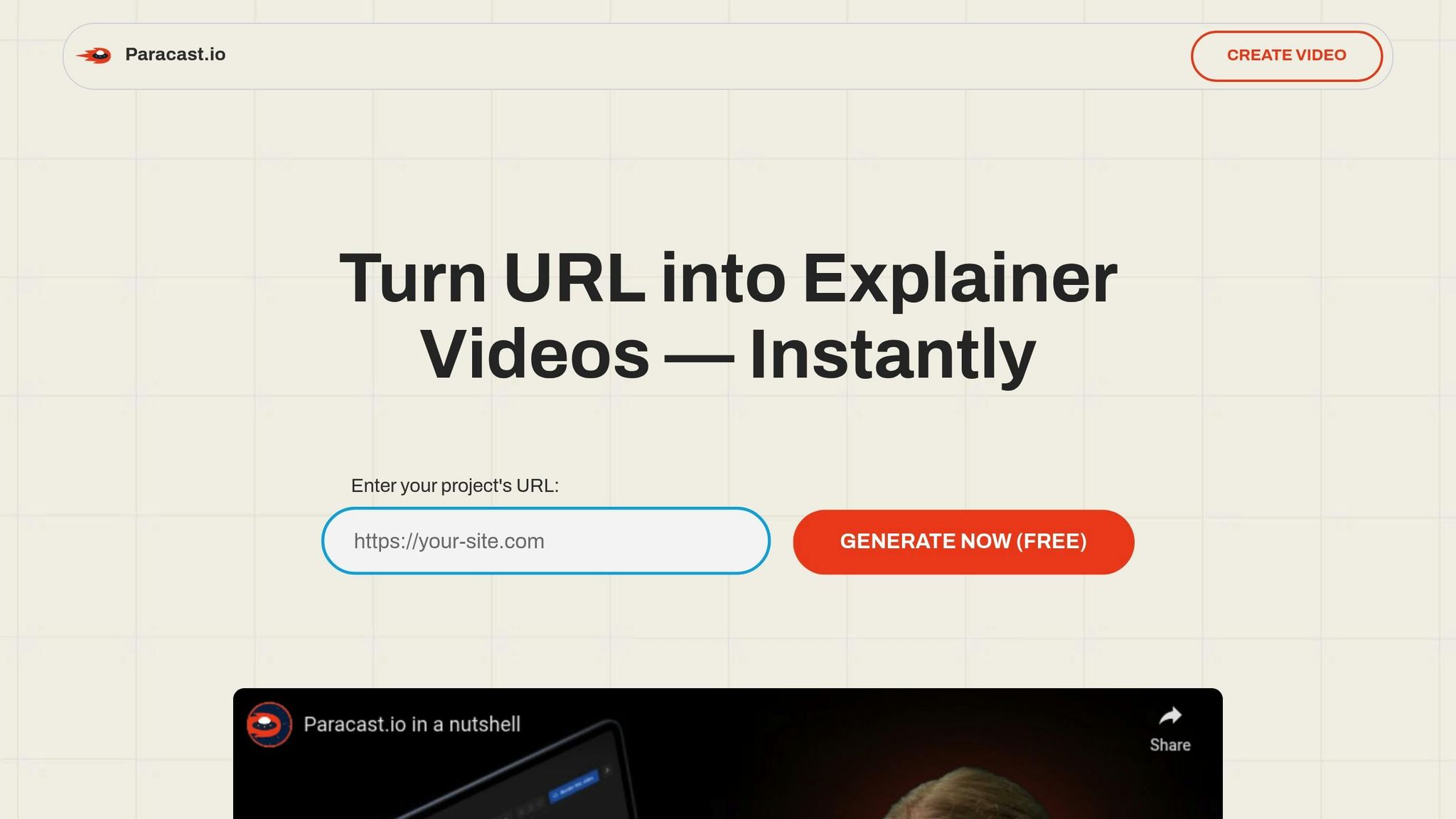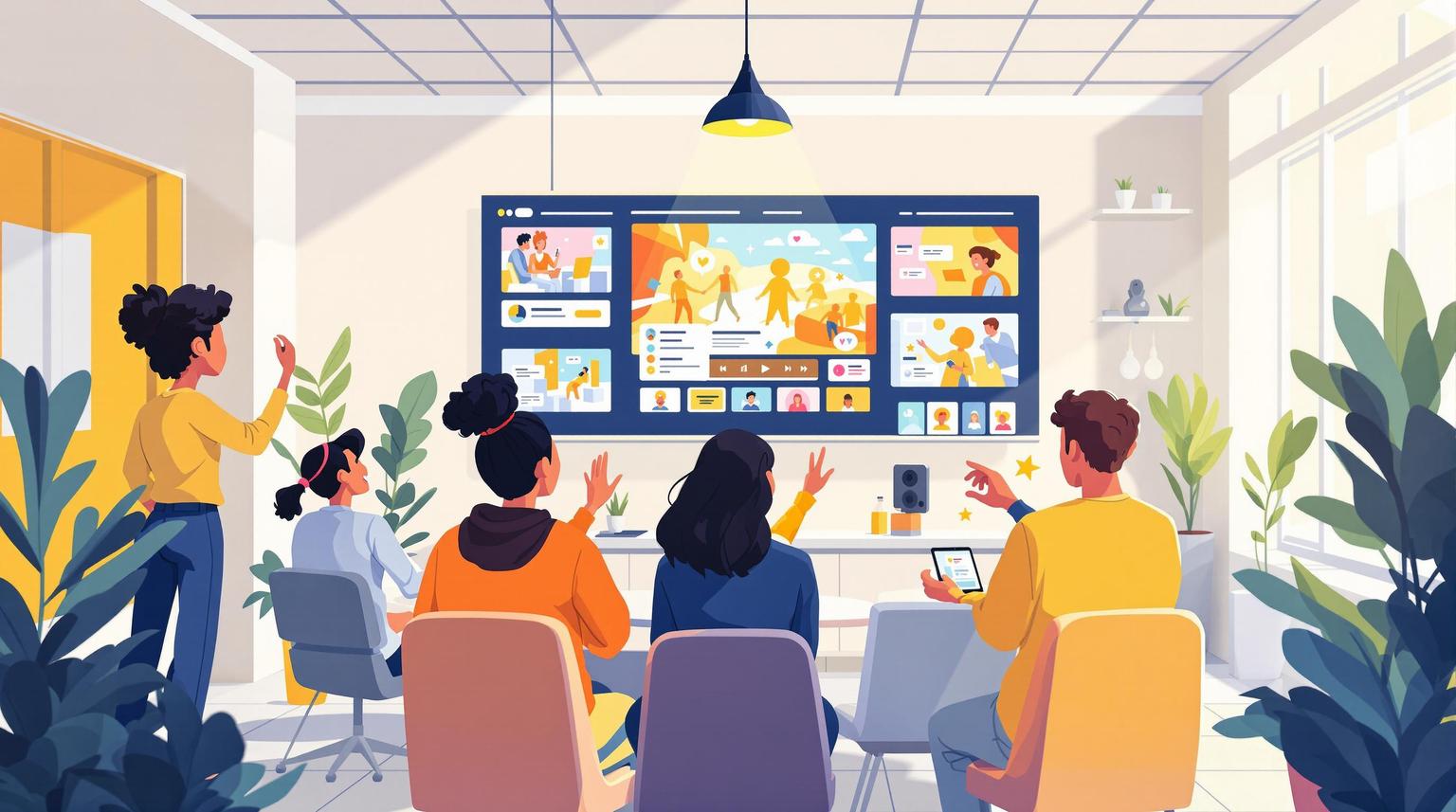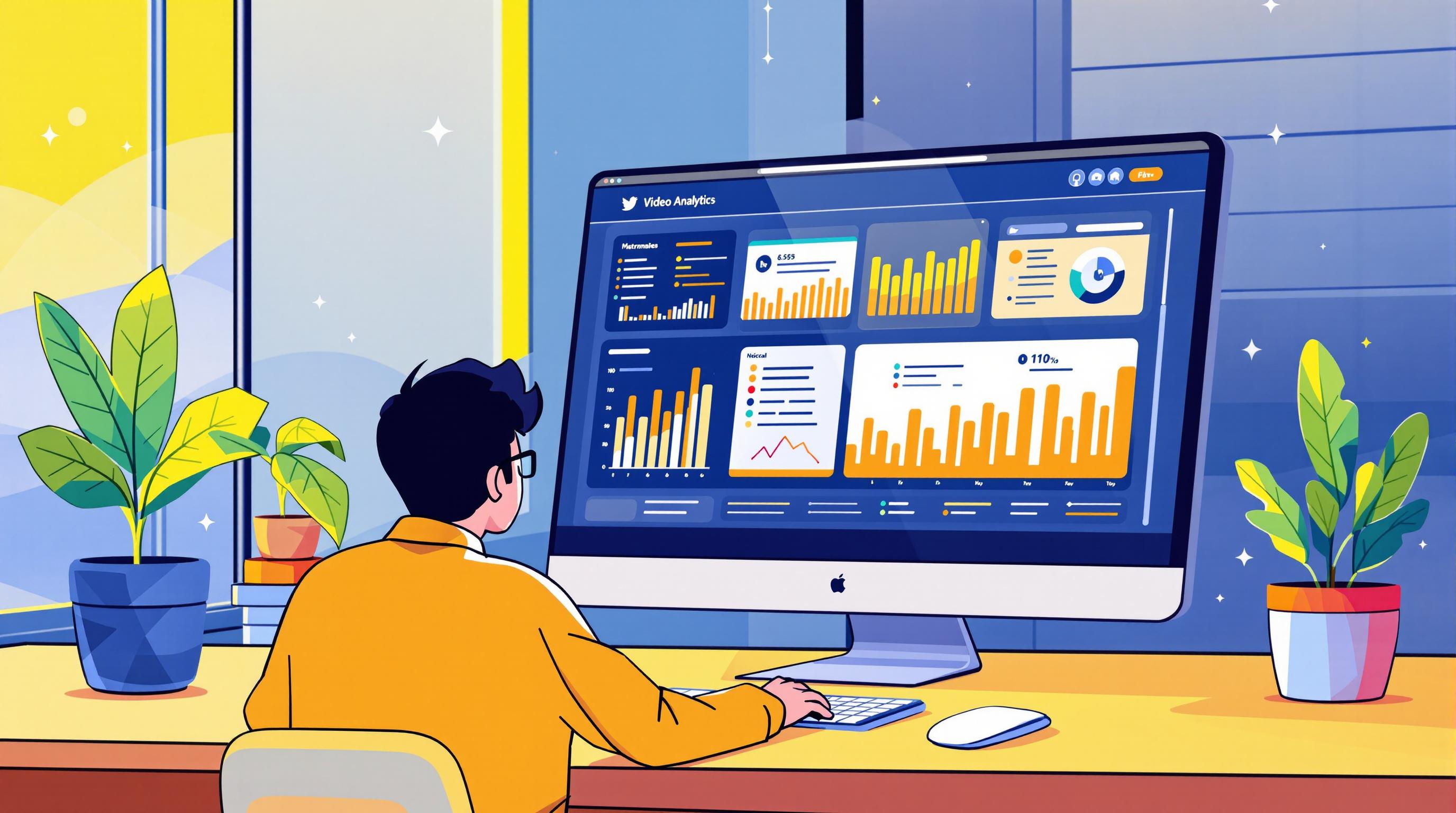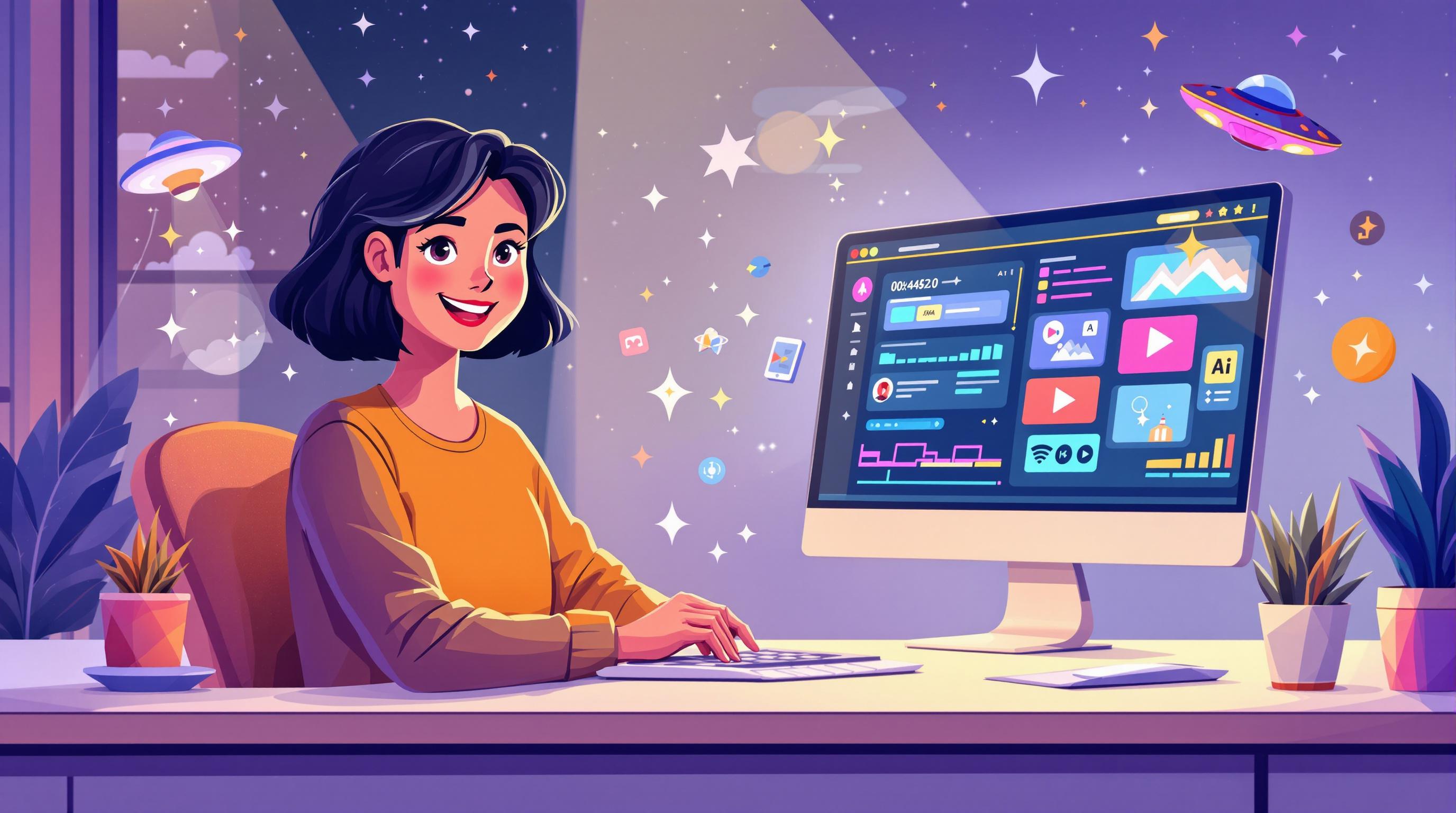Video personalization is no longer a luxury - it’s what audiences expect. AI is transforming video marketing by creating tailored, real-time content that resonates with individual viewers. Businesses can now deliver videos that adjust dynamically based on user behavior, preferences, and context, leading to:
- Higher engagement: Personalized videos hold attention longer and drive interaction.
- Better conversions: Targeted messaging reduces friction and prompts action.
- Cost and time savings: AI automates video creation, eliminating the need for multiple versions.
- Scalable solutions: A single video can morph into thousands of variations for different audiences.
AI tools like Paracast.io simplify this process, enabling businesses to convert website content into ready-to-use promotional videos. By automating editing, offering templates, and using real-time data, these tools make personalization accessible and efficient. The result? Stronger connections with viewers and measurable marketing success.
Revolutionizing Marketing with Scalable AI-Generated Personalized Videos
Problems with Standard Video Marketing
Traditional video marketing methods face several challenges that make it harder to connect with audiences on a deeper level. As consumer expectations grow and competition for attention heats up, these obstacles become even more apparent, highlighting the need for smarter, more tailored solutions.
Low Engagement Rates
Generic video content often struggles to hold viewers' attention in today’s crowded digital world. When videos rely on broad, one-size-fits-all messaging, they often fail to connect with viewers' specific interests, needs, or where they are in their buyer's journey. Studies show that many viewers stop watching early if the content doesn’t feel relevant to them.
This problem is even worse when businesses rely solely on broad demographic data instead of digging into individual behaviors. For instance, imagine a software company producing one explainer video for all its potential customers. A small business owner and an enterprise IT manager likely have very different concerns, yet they’re served the same message - leaving both feeling disconnected.
High Production Costs and Time Requirements
Creating personalized video content for different audience segments has traditionally been expensive and time-consuming. Each version requires its own script, filming, editing, and post-production work, making it a massive undertaking for most businesses.
On top of that, manual production processes drive up costs and slow down timelines, leaving little room for quick pivots or adjustments. By the time a video campaign is ready to launch, customer preferences or market trends may have already shifted. These challenges make it tough for businesses to deliver video content that meets the needs of diverse audiences quickly and effectively.
Difficulty Reaching Different Audiences
Standard video marketing often falls short when it comes to addressing the varied needs and preferences of different audience segments. A single video rarely resonates equally across industries, company sizes, regions, or stages of the buyer's journey.
Take, for example, a B2B software video. If it doesn’t address the unique concerns of healthcare providers versus financial services firms, it risks losing relevance - and engagement. Geographic and cultural nuances add another layer of complexity. A promotional video tailored for the U.S. market might reference regulations, cultural norms, or business practices that don’t translate well internationally.
Even within the same audience, a mismatch in messaging can hurt. A video designed for enterprise clients may overwhelm small business owners with too much complexity, while enterprise prospects might dismiss content that feels overly simplistic. Timing also plays a critical role - new prospects may need educational videos that explain industry challenges, while existing customers are looking for advanced tips or integration guides. Standard videos, which fail to adapt to these differences, often end up pushing viewers away instead of pulling them in.
AI Technologies That Enable Real-Time Video Personalization
AI-driven solutions are transforming video content by addressing challenges like low engagement and high production costs. These technologies automate the process of tailoring videos to individual viewers, creating personalized experiences at scale without requiring manual input. By analyzing viewer data and dynamically adjusting content, AI ensures that each viewer gets a version of the video that resonates with them.
Dynamic Content Generation
AI has revolutionized how videos are structured by breaking them into reusable building blocks. These blocks can be rearranged and customized based on the viewer's characteristics, such as their interests, location, or industry. For instance, AI can swap out product demos, adjust pricing details, or include industry-specific examples - all in real time.
This works by pinpointing decision points in the video where content can branch based on viewer data. For example, an AI system might show one product feature to startups and a completely different one to enterprise clients. It can also modify text overlays, graphics, music, or entire scenes to create a seamless and personalized experience.
The personalization kicks in as soon as the viewer hits play. The AI evaluates data like the viewer's location, job title, or past interactions and assembles the most relevant version of the video. A single base video can morph into various versions - highlighting different features for marketing teams versus sales teams or emphasizing benefits tailored to small businesses versus large corporations. This dynamic assembly ensures that every viewer sees content that feels directly relevant to them.
Conditional Logic and Personalization Rules
At the heart of personalized videos is a decision engine powered by conditional logic. This system uses a set of rules to determine which content elements to show each viewer, based on real-time data.
These rules can be incredibly detailed. The AI might consider factors like the viewer's geographic region, job title, referral source, or even the time of day they're watching. For example, a first-time visitor who is a marketing manager might see a video introducing marketing use cases, while a returning viewer from the same company could skip the basics and go straight to advanced features.
By layering multiple conditions, the AI refines its content delivery even further. It can also incorporate external data, such as industry trends or seasonal patterns, to ensure the video feels timely and relevant. This precision helps create a viewing experience that feels personalized at every level.
AI-Generated Voiceovers and Avatars
AI has made it easier than ever to create natural-sounding voiceovers and digital avatars for personalized video content. Advanced text-to-speech technology can produce professional-quality narration tailored to different audience segments, eliminating the need for multiple voice recordings. Businesses can now adapt their messaging quickly and affordably.
For example, an AI system can generate different scripts for various viewer groups, emphasizing specific benefits or using industry-specific language. The result? A single base video can deliver slightly different messages to different audiences, all with consistent, polished narration.
Digital avatars take personalization a step further. These AI-generated presenters can adjust their appearance, clothing, or even speaking style to better connect with specific viewers. While still evolving, this technology is already being used to create engaging and relatable video experiences tailored to diverse audiences.
Real-Time Analytics and Response Triggers
The most advanced AI video systems don't stop at initial personalization - they continuously adapt based on real-time viewer interactions. These systems monitor how viewers engage with the video, tracking actions like pauses, skips, or rewinds, and make adjustments on the fly.
For instance, if a viewer seems to lose interest, the AI might shorten the video or switch to a different version mid-stream. If someone replays a specific section, the system could respond by offering additional content or sending a follow-up email with related resources. This creates a seamless link between the video and broader marketing efforts.
Every interaction feeds into the AI's understanding of what works for different audience segments. Over time, this feedback loop improves the system's ability to deliver even more personalized and effective content. By combining real-time responsiveness with continuous learning, AI ensures that each video becomes smarter and more engaging with every viewer.
Strategies for Real-Time Video Personalization
AI has revolutionized how businesses approach video content, moving beyond generic, one-size-fits-all approaches. By using strategies like personalized recommendations, dynamic visuals and messaging, and automated editing for multiple platforms, brands can create video experiences tailored to individual viewers. These methods not only boost engagement but also address efficiency challenges head-on.
Personalized Video Recommendations
AI-powered recommendations ensure viewers see content that aligns with their unique interests. By analyzing user data - such as viewing habits, click behavior, and demographic details - AI suggests videos that are most relevant to each individual.
For example, new users might receive introductory content, while returning customers are shown product demos or tutorials tailored to their needs. Over time, the AI refines its recommendations, learning from user interactions to deliver even more precise suggestions. A great example of this in action is an e-commerce brand that used personalized product recommendation videos based on browsing and purchase history. The result? A fourfold increase in customer engagement and a noticeable boost in conversion rates.
Timing also plays a key role. Instead of overwhelming viewers with generic content, AI identifies the right moment to deliver a specific video, ensuring every interaction feels relevant and intentional.
Dynamic Visuals and Messaging
Static, one-size-fits-all videos are quickly becoming outdated. AI now makes it possible to adjust visual elements and messaging in real time, tailoring them to match the viewer's profile.
This personalization can range from subtle tweaks - like customizing on-screen text or calls-to-action - to more dramatic changes, such as altering entire scenes to highlight features that resonate with specific audience segments. For instance, a SaaS company might create one version of a video showcasing collaboration tools for marketing teams and another emphasizing analytics dashboards for data analysts, all using the same base template.
Context also matters. AI can adjust the video’s opening scenes or overall messaging depending on how a viewer arrived at it - whether through a social media ad or a Google search. This ensures the content remains relevant and engaging at every stage of the customer journey.
Automated Editing and Multi-Platform Distribution
Manually tailoring videos for different platforms is both time-consuming and inefficient. AI streamlines this process by automating key tasks like adjusting aspect ratios, adding captions, and editing scenes to fit platform-specific requirements.
For example, AI can create square videos for Instagram, vertical ones for TikTok, and widescreen versions for YouTube - all from the same source video. It also adds captions and custom descriptions tailored to each platform’s audience.
Additionally, AI identifies key scenes, adjusts video lengths to suit different platforms, and even modifies pacing to align with viewer attention spans. Automated captioning and translation expand the video’s reach, making it accessible to audiences in multiple languages.
The time savings are incredible. Many companies now produce thousands of unique videos at scale in a fraction of the time it used to take. What once required weeks of manual effort can now be done in minutes, freeing up marketing teams to focus on strategy while maintaining consistent branding across all versions.
sbb-itb-5bfa442
Benefits of AI-Powered Video Personalization
Switching from generic video content to AI-driven personalized experiences offers a range of advantages: higher engagement, improved conversion rates, reduced costs, and stronger audience loyalty. Let’s break down how AI is reshaping video marketing.
Higher Viewer Engagement
Personalized videos grab attention by aligning with individual viewer preferences. Using tailored recommendations and targeted messaging, they keep audiences watching longer and even encourage interaction. Features like clickable suggestions or customized calls-to-action make the experience more engaging and interactive.
Better Conversion Rates
When content feels personal, it makes the journey from awareness to action much smoother. AI ensures the right message reaches the right person at the right time, addressing their specific needs. This reduces barriers and prompts quicker, more meaningful responses, driving better conversion rates.
Lower Costs and Faster Production
AI simplifies video production by enabling businesses to create multiple personalized versions from a single base video. Instead of producing separate videos for different audiences, AI generates tailored variations, saving time and money. This efficiency allows marketing teams to adapt campaigns on the fly, respond to trends, and fine-tune messages without sacrificing quality.
Stronger Audience Relationships
Personalized videos go beyond short-term results - they help build lasting connections. Consistently delivering relevant content fosters trust and loyalty over time. As AI systems learn more about viewers’ preferences, they refine the content further, deepening these relationships. Tools like Paracast.io are already leveraging AI to craft highly engaging, personalized video experiences that resonate with audiences.
How Paracast.io Enables Real-Time Video Personalization

Paracast.io takes the concept of AI-driven video personalization and turns it into a practical tool for businesses. Whether you're a startup, an agency, a freelancer, or part of a small team, this platform helps you convert website content into eye-catching promotional videos. By cutting out the usual hurdles of video production, Paracast.io delivers the tailored, engaging experiences today's audiences crave.
AI-Powered Video Creation from URLs
At the heart of Paracast.io’s innovation is its ability to create promotional videos directly from website URLs. All users have to do is input their website link, and the platform’s AI takes it from there, generating animated videos complete with dynamic text overlays and background music. This ensures messaging stays fresh and relevant.
What sets this apart is the AI’s ability to work in real time. Businesses can quickly adapt their videos to reflect market shifts, product updates, or new opportunities - no waiting around for traditional production timelines.
A user summed up its ease of use perfectly:
"Just discovered @paracast_io by @alexanderisorax - the AI magician that turns websites into stunning videos! Input a URL, get an animated video with text and music. 🤩 It's so easy, you've got to see it to believe it."
– Zeng 💜 (@zeng_wt)
Ready-Made Templates for Every Occasion
Paracast.io doesn’t just stop at video creation; it also offers a wide range of templates tailored to different business needs. These templates are perfect for scenarios like product demos, feature announcements, partnership news, milestone celebrations, hiring updates, VC funding reveals, and special promotions.
This variety ensures businesses can maintain a consistent brand image while tailoring their content for specific audiences. Whether it’s introducing a new integration or sharing a company achievement, the platform allows users to pick the right template and let the AI handle the heavy lifting, pulling relevant information directly from their website.
Easy Editing and Custom Branding
User experience is a top priority for Paracast.io, with its editing tools designed to be so straightforward that users can master them in just 10 minutes. In fact, they’re so confident in this claim that they offer a full refund if users don’t hit that learning curve. The interface allows businesses to tweak colors, fonts, logos, and messaging, ensuring every video aligns with their brand identity.
All videos are produced in crisp 1080p quality, and paid plans come watermark-free, ensuring a polished, professional look across all marketing platforms. With pricing starting at just $3 per video on a credit-based system, Paracast.io is affordable for small teams and individual creators while also scaling up for larger operations. This blend of AI-powered efficiency and customizable branding makes Paracast.io a standout solution for modern video production.
Conclusion: The Future of AI-Powered Video Personalization
AI-powered video personalization is reshaping how businesses connect with their audiences by delivering tailored, real-time experiences. This shift bridges the gap between one-size-fits-all content and the growing demand for more individualized interactions, allowing brands to create stronger, more meaningful connections at scale.
The integration of AI technologies - like automated editing, dynamic content generation, and real-time analytics - has opened up new possibilities for video marketing. By reducing the need for resource-heavy production, businesses can shift their focus to crafting impactful strategies and messages, leaving the technical details to AI.
The advantages of this approach are clear. Real-time personalization is no longer just a perk; it’s quickly becoming the baseline expectation for consumers across digital platforms. Studies show that personalized videos consistently outperform generic content in engagement, conversions, and building loyal audience relationships. Companies that hesitate to adopt these tools risk losing relevance in a market that increasingly values tailored experiences.
Platforms such as Paracast.io demonstrate how AI is making video personalization accessible to everyone, from startups to small teams. By turning website URLs into promotional videos with customizable templates, these tools remove traditional barriers like time and cost. What once took days can now be accomplished in minutes, giving businesses of all sizes the ability to deliver high-quality, personalized content.
As AI continues to advance, we can expect even greater precision in targeting, real-time adjustments, and seamless integration across multiple channels. Companies embracing these innovations now are setting themselves up to thrive in a digital world where personalized, engaging content isn’t just preferred - it’s expected.
FAQs
How does AI personalize video content for viewers in real time?
AI has the ability to customize video content on the spot by analyzing factors like what viewers prefer, how they interact, and their past behavior. Through advanced machine learning, it tweaks or picks video elements that align with individual interests.
This involves making decisions in real time using adaptive algorithms, ensuring every viewer gets content that feels personalized to them. The result? Increased engagement and a more relevant viewing experience.
What are the key advantages of using AI for real-time video personalization?
AI-powered video personalization brings a range of advantages over traditional video marketing strategies. By dynamically tailoring content to match viewer preferences and behaviors, it ensures videos feel more relevant and engaging. This precise targeting helps grab and hold the audience's attention more effectively.
On top of that, AI streamlines video production by automating repetitive tasks, cutting both time and costs. This makes it possible to create personalized, scalable content without breaking the bank. The result? Businesses can share tailored messages with their audience in real-time, boosting both engagement and overall marketing impact.
How can businesses create AI-powered video content that stays relevant and connects with different audience groups?
To create video content that captures attention and feels meaningful to a variety of audiences, businesses should merge AI-driven personalization with human insight. While AI excels at analyzing audience data to customize content for specific demographics, the human touch ensures the content maintains cultural awareness and feels genuine.
Keeping an eye on audience feedback and performance metrics is crucial. This allows businesses to fine-tune their videos, making them more aligned with audience expectations and evolving tastes. By combining AI's ability to process data with the creativity and sensitivity of human oversight, businesses can produce videos that truly resonate with their viewers.


